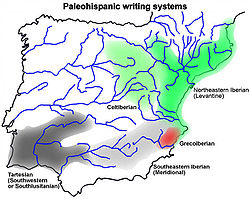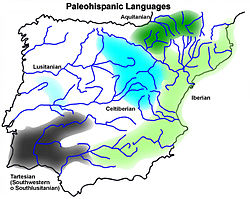Iberian scripts








The Iberian scripts are the
Variants
There are two main graphic as well as geographic variants in the family:
- Northeastern Iberian script
- Dual variant (4th century BCE and 3rd century BCE) (tentative)
- Non-dual variant (2nd century BCE and 1st century BCE)
- Southeastern Iberian script
In the sense that the Iberian scripts are the scripts created for the Iberians to represent the Iberian language, the
The northeastern Iberian script is often known simply as the Iberian script, because it is the script of 95% of known Iberian inscriptions. These have been found mainly in the northeastern quadrant of the Iberian Peninsula, mostly along the coast from Languedoc-Roussillon to Alicante, but with a deep penetration on the Ebro valley.
The southeastern Iberian script is poorly attested, and there are some gaps in the records: There are no positively identified symbols for /gu/, /do/, and /m/, for example. Unlike the
There is substantial graphic variation in the Iberian glyphs, and over the past several decades many scholars have come to believe that, at least in northeastern Iberian script (and recently also in Celtiberian script) some of this variation is meaningful. It appears that the original simple letters were assigned specifically to the voiced consonants /b/, /d/, /g/, whereas the voiceless consonants /t/ and /k/ were derived from /d/ and /g/ syllables with the addition of a stroke. (This is the so-called dual signary model: see the image at right). If correct, this innovation would parallel the creation of the Latin letter G from C by the addition of a stroke.
Typology
Excepting the
The southeastern script was written right to left, as was the Phoenician alphabet, whereas the northeastern script reversed this to left to right, as in the Greek alphabet.
Origins
The Iberian scripts are classified as
See also
- Iberian language
- Paleohispanic scripts
- Pre-Roman peoples of the Iberian Peninsula
Notes
- ^ "Paleohispanic keyboard". keyman.com. Retrieved 2024-04-04.
- ^ Ferrer, J., Moncunill, N., Velaza, J., & Anderson, D. (2017). Proposal to encode the Palaeohispanic script.
References
- Anderson, James M. (1988) Ancient Languages of the Hispanic Peninsula.
- Correa, José Antonio (2004): «Los semisilabarios ibéricos: algunas cuestiones», ELEA 4, pp. 75–98.
- Correa, José Antonio (1992): «Representación gráfica de la oposición de sonoridad en las oclusivas ibéricas (semisilabario levantino)», AIΩN 14, pp. 253–292.
- Ferrer i Jané, Joan (2005) Novetats sobre el sistema dual de diferenciació gràfica de les oclusives sordes i sonores, Palaeohispanica 5, pp. 957–982.
- Gómez-Moreno, Manuel (1922): «De Epigrafia ibérica: el plomo de Alcoy», Revista de filología española 9, pp. 34–66.
- Hoz, Javier de (1987): «La escritura greco-ibérica», Veleia 2–3, pp. 285–298.
- Hoz, Javier de (1985): «El nuevo plomo inscrito de Castell y el problema de las oposiciones de sonoridad en ibérico», Symbolae Ludouico Mitxelena septuagenario oblatae, pp. 443–453.
- Maluquer de Motes, Joan (1968): Epigrafía prelatina de la península ibérica, Barcelona.
- Quintanilla, Alberto (1993): «Sobre la notación en la escritura ibérica del modo de articulación de las consonantes oclusivas», Studia Palaeohispanica et Indogermánica J. Untermann ab Amicis Hispanicis Oblata, pp. 239–250.
- Rodríguez Ramos, Jesús (2004): Análisis de Epigrafía Íbera, Vitoria-Gasteiz 2004, ISBN 84-8373-678-0.
- Rodríguez Ramos, Jesús (2002): «La escritura ibérica meridional», Zephyrus 55, pp. 231–245.
- Untermann, Jürgen : Monumenta Linguarum Hispanicarum, Wiesbaden. (1975): I Die Münzlegenden. (1980): II Die iberischen Inschriften aus Sudfrankreicht. (1990): III Die iberischen Inschriften aus Spanien. (1997): IV Die tartessischen, keltiberischen und lusitanischen Inschriften.
- Velaza, Javier (2004): «La escritura en la península ibérica antigua», La escritura y el libro en la antigüedad, Madrid, pp. 95–114.
- Velaza, Javier (1996): Epigrafía y lengua ibéricas, Barcelona.
External links
- Los primeros sistemas de escritura en la Península Ibérica (Course program)
- Ancient Scripts – Iberia
- Levantine Iberian Script
- Meridional Iberian Script
- Greek Iberian Script
- Celtiberian Script
- Tartessian / South-Lusitanian Script
- "On the Story of the Decipherment of Iberian Writing" by Jesús Rodríguez Ramos
- Detailed map of the Pre-Roman Peoples of Iberia (around 200 BCE)
- Links to images of inscriptions
